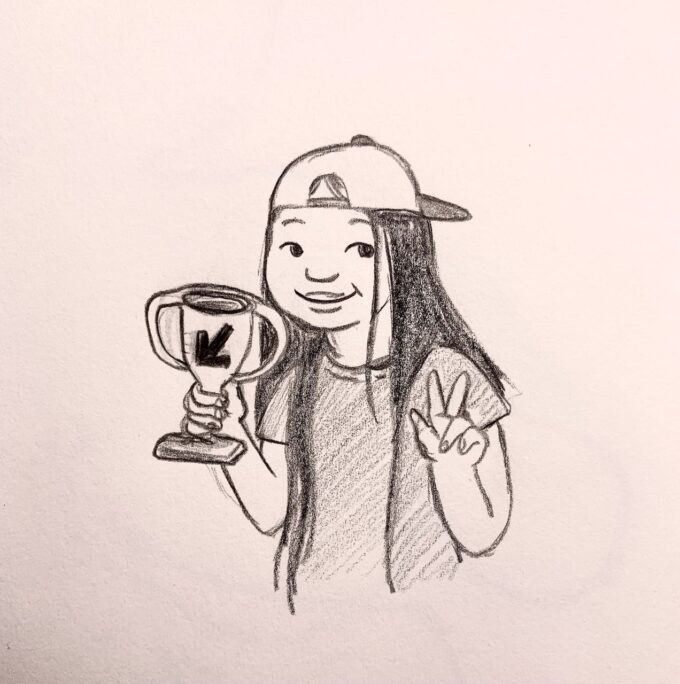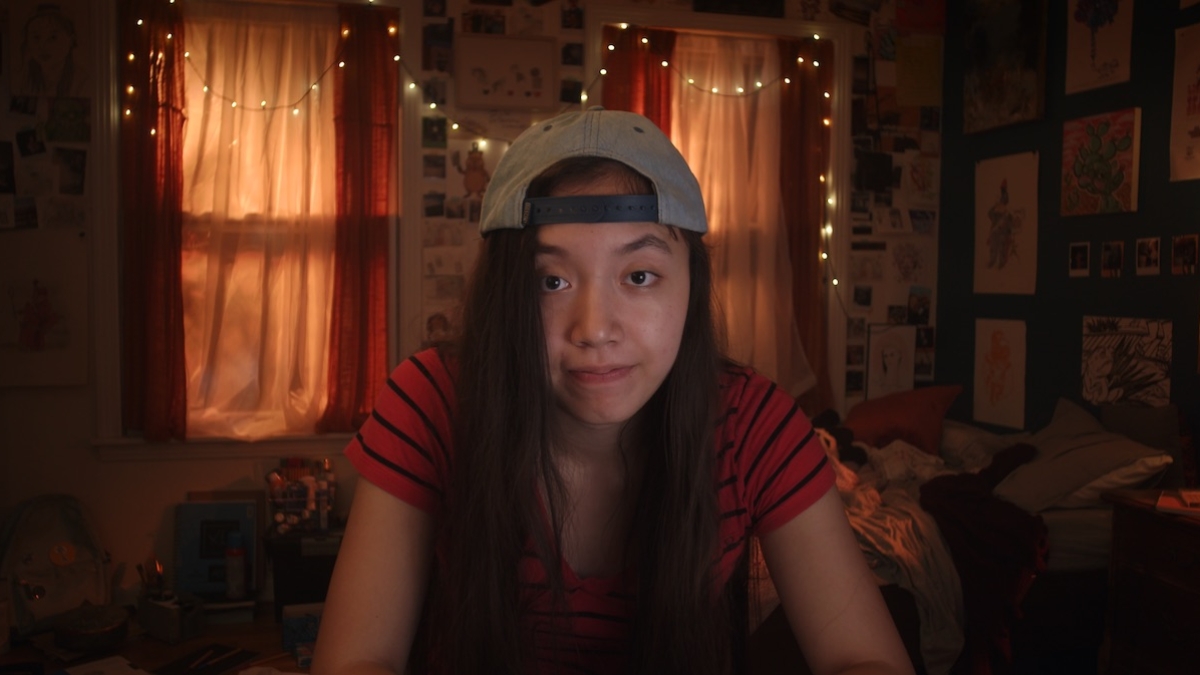Written By: Kyubin Kim
This article may contain spoilers.
There’s something magical happening with teen coming-of-age stories lately and I spoke with lead actor Emma Galbraith to discuss our love of the YA genre, collaborative storytelling, and writing authentically in Mei Makino’s feature directorial debut “Inbetween Girl.”
In the film, Angie Chen (Emma Galbraith) is a high school senior in the island city of Galveston, Texas. Her life is defined by a series of never ending impasses: she’s stuck in a secret love triangle, caught in between her divorced parents and negotiating the poles of her “not quite Chinese” and “not quite white” mixed-race identity. Plus we can’t forget the fact that she’s a teenager, suspended awkwardly in between the stages of childhood and adulthood.
For a girl who seems to be stuck in life’s gray area, Angie’s voice is candid and confident. The film opens with Angie teasing Liam (William Magnuson), her crush and the most unattainable guy at her private Catholic school. Liam is dating Instagram influencer Sheryl White (Emily Garrett), but crawls into Angie’s window one night, kicking off their secret love affair. The film initially seems like any other unassuming young adult rom-com, with the teenage angst and moodiness, awkward sexual “firsts” and the quintessential struggle to find oneself. But there’s a lot going on under the surface of “Inbetween Girl.” The characters may be young, morally flawed and emotionally volatile, but the film does not shy away from engaging in “grown-up” dialogues about race and identity.
The story is heavily personal, an infusion of director Mei Makino’s experience growing up Japanese American in Texas and actor Emma Galbraith’s Chinese American background. The script was mutable, like “Play-Doh,” Galbraith recalled, edited in collaboration with the teenage actors and cultural consultants to feel as authentic as possible. Galbraith commented, “[Mei] is Japanese American, I’m Chinese American and Angie’s Chinese American. We had a lot of conversations about what it’s like to have a family dynamic where your dad is Asian but your mom is white which is something that Mei knows about, but I don’t know about.”
Moreover, in order to keep the film true to the Gen Z demographic, Galbraith discussed how, “[Mei] made this very active choice to consult her young talent on youth culture to make sure she got it right.” From the references to Instagram and social media influencers, to the slang and irreverent humor that teenagers simply get, director Mei Makino skillfully spotlights the quotidian teenaged lives at this moment.
At the same time, “Inbetween Girl” is somewhat of a genre-defiant teen movie. The film is largely chronological, but switches to vlog-style “Dear Future Angie” segments where Angie films video time capsule letters to her 26-year-old self. All the videos were filmed on a grainy Samsung Hi8 camcorder, embodying nostalgia and a certain sense of close intimacy. These moments make the film feel more introspective. Galbraith remembers reading the script for the first time, and feeling that “[Angie’s] reaching out of time to find the one person that understands what she’s going through.”
The multimedia intertextuality of the film creates layers of access points for the audience to feel immersed. True to Angie’s background as an artist, the film features playful and bubbly artwork by Texan illustrator Larissa Akhmetova. In one lust-filled sex scene montage between Angie and Liam, the screen cuts to black and you can only hear the two actors’ rhythmic breaths and Angie giving Liam instructions to do what feels good to her. Angie’s smitten voiceover is complemented by a series of still photos of Angie and Liam making out, decorated by heart doodle animations. “I’m really learning how to bang, Future Angie,” she says excitedly.

As fun and humorous as this coming-of-story film is, “Inbetween Girl” also taps into the subtle “ugly” feelings of uncertainty that we can empathize with and learn from. Makino’s scenes on Angie’s racial and cultural insecurities were impressively written.
As the daughter of divorced parents, Angie traverses from living with her white, workaholic mother Veronica (Liz Waters) to spending time with her Chinese father Fai (KaiChow Lau). In the film, Angie meets her father’s new Chinese family, her stepmother Min (ShanShan Jin) and stepsister Fang (Thanh Phuong Bui), and can’t help but feel inadequate. “It’s just weird to be reminded that there’s this whole other side to him, the side of him that I’m not really a part of,” Angie says.
In one scene, Angie is making Chinese dumplings (jiaozi) for the first time with her stepmother and stepsister. There’s tension as her stepmother and stepsister talk in Mandarin, leaving Angie out. Her stepmother unintentionally comments on Angie’s poor Chinese language skills: “Many ABC’s (American born Chinese) who have no sense where they came from.” Angie is immediately fired up with frustration.
In the interview, Galbraith noted that, “If you’re not white, everyone assumes you’re connected to whatever else you are,” from the language, to the cultural cues and traditions. Angie, who lost the one access point to engage with her Chinese culture when her dad left, feels hollowed out. “You feel like you’re falling short of everyone’s expectations … It’s feeling so out-of-place,” Galbraith said. In Makino’s film, it’s interesting that Angie doesn’t alienate or reject her culture, but exists in a state of perpetual longing for something that is unknowable.
When talking about Angie’s complicated relationship to her biracial identity, Galbraith reframed the fractional way we’re used to discussing race by pointing out, “You’re not half, you’re double. You’re more than the sum of your parts. The real gift that Angie receives is learning to understand her identity is not fractured but layered and complex.” “Inbetween Girl” does not conclude with a determined answer to “So how do you connect to a part of your culture you feel no ownership over?,” but acknowledges how it is a universal, ongoing struggle, not one that a 17-year-old must figure out.
When we think about the multiplicity of identities that people can inhabit simultaneously rather than in fixed categories, inbetweenness is not a burden or blockage, but an entry-way to feel content in the space you occupy. “Inbetween Girl” is comforting. It shows the depth of teenage experiences that are often written off and redefines young adult films as conduits for exploring how coming-of-age is compounded by race, culture and family. Being stuck “in between” can feel lonely but Mei Makino’s film teaches us that there’s beauty in being both and many.
“Inbetween Girl” makes its New York City premiere at the 44th Asian American International Film Festival. Ticket and screening information can be found here.

